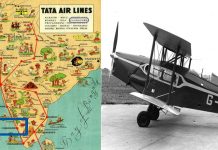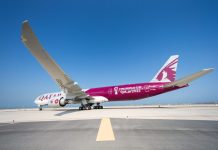The Boeing 747-400 is an improvement of the 747-300, and is the best-selling model of the Boeing 747 family of jet airliners.
Air India 747-400 takes off from Chennai Airport
Video – VOMM Spotter
While retaining the four-engine wide-body layout of its predecessors, the 747-400 embodies numerous technological and structural changes to produce a more efficient airframe. Its most distinguishing features versus preceding 747 models are 6-foot (1.8 m) winglets mounted on 6-foot (1.8 m) wing tip extensions, which are found on all 747-400s except for Japanese domestic market versions.
The 747-400 is equipped with a two-crew glass cockpit, which dispenses with the need for a flight engineer, along with more fuel-efficient engines, an optional fuel tank in the horizontal stabilizer, and revised fuselage/wing fairings. The aircraft also features an all-new interior with upgraded in-flight entertainment architecture. As on the 747-300, passenger variants include a stretched upper deck as standard. The model has a maximum capacity of 660 passengers with the 747-400D variant, and can fly non-stop for up to 7,670 nautical miles (14,200 km) with maximum payload, depending on model.
Northwest Airlines first placed the 747-400 in commercial service in February 9, 1989. The 747-400 was produced in passenger (−400), freighter (−400F), combi (−400M), domestic (−400D), extended range passenger (−400ER) and extended range freighter (−400ERF) versions. The last 747−400, a -400ERF, was delivered in 2009. The 747-400 is the second-most recent version of the Boeing 747 family, having been superseded by the improved Boeing 747-8.
The 747-400’s airframe features extended and lighter wings than previous 747s, capped by winglets. The winglets result in a 3 percent increase in long-range cruise, improved takeoff performance, and higher cruise altitudes. The extended wingspan also gains an additional leading edge flap section. When unfurnished, the basic 747-400 fuselage is lighter than preceding models, but when fitted out it is heavier and stronger than previous models. The landing gear uses the same configuration as previous 747s, but with carbon brakes replacing the previous steel ones, and overall weight savings of 1,800 pounds (820 kg).
The 747-400’s glass cockpit features CRT displays which show flight instrumentation along with engine indication and crew alerting system(EICAS) diagnostics. The flight engineer station on previous 747s is no longer installed, and the new displays and simplified layout results in a two-thirds reduction of switches, lights, and gauges versus the Classic 747. Other new systems include an advanced Honeywell flight management computer (FMC) which assists pilots in calculating optimal altitudes and routes along with a Rockwell-Collins central maintenance computer (CMC) which automates troubleshooting tasks.
The redesigned 747-400 interior features new cabin sidewalls, heat-resistant phenolic glass, carbon composite paneling, and larger storage bins. An enhanced in-flight entertainment framework, called the Advanced Cabin Entertainment/Service System (ACESS), debuted on 747-400, which integrates 18-channel audio capability, four passenger intercom announcement zones, inter-cabin telephones, and passenger lighting into a central system. An eight-bunk overhead crew rest is installed above the aft cabin, while a second crew rest area is located on the upper deck behind the cockpit for flight crew use.
The last few 747-400s delivered features the Boeing Signature Interior, derived from the Boeing 777. These aircraft are in service with Qantas and China Airlines.



















